|
If you've been in Japan for even a day, you'll have been struck by the phenomenal ubiquity of the vending machine, a cultural icon sitting not only on most street corners, but also astride several surprisingly deep undercurrents of Japanese society.
For the price of a few coins, these mechanical ministers -- always available, always open, always accepting -- serve up sustenance that is fresh, neatly packaged, and perfectly heated (or cooled, as the season dictates) for gracious consumption. And while the jidouhambaiki's sandwiches and beer may not soothe the soul like the communion bread and wine, they'll at least be tastier than the stale Fritos and tepid Coke expelled by machines in the West. In the past few years, due at least in part to this island nation's natural gadgety inventiveness, machines here have morphed into sophisticated electrical commerce platforms providing everything from food to panty hose. And they're part of what makes living in Japan fun.
All told, Japan has some 5,537,500 machines of all types in service, and these accounted for some ¥3,086 billion in sales in 1999. Soon most, if not all, will be connected to the Internet, or to wireless networks that channel inventory and sales data directly into corporate databases, while news, ads, and streaming video and audio are funneled back to the machines. The Jetsons never had it so good. We checked out the latest models at November's Vendex 2000 in Tokyo.
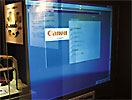 ATTENTION GETTER ATTENTION GETTER
Jaded consumers need a visual jolt to separate them from their cash these days, and, like the appearance of CRT and LCD screens on vending machines, electronic displays for public areas (shops, malls, in-store sale areas) are now key for grabbing eyeballs. The Magical Display, from Canon, combines an acrylic plastic layer, a glass layer, and a newly developed "milky white" layer. Together, these transmit or reflect super-clear images from one or more digital LCD projectors, reproducing output from any VTR, TV, PC, or DVD player. The Magical Display can also show holograms, and comes in sizes from 40 to 100 inches. Retail price: ¥200,000 to ¥914,000, depending on config.
www.canon-sales.co.jp/Product/projector/solution/magical.html
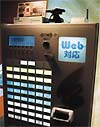 WATCH YOUR MANNERS
WATCH YOUR MANNERS
This vending machine, part of a new series produced by Toyo Communication Equipment (it's been in business since 1891), sells tickets for fast-food counters or company cafeterias serving ramen, udon, or other prepared, set meals. Drop in your coins, pick the meal you want, and then take the ticket to the lunch lady behind the counter. Meanwhile, she'll keep an eye on you via the CCD camera mounted on top, which can transmit images a few feet or over the Net. The helpful sales guy on duty at this display explained the CCD camera was "for security." No word on price, privacy, or when this machine will hit the market.
www.toyocom.co.jp
|
|
|
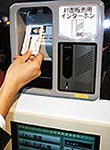 IDENTIFICATION, PLEASE
IDENTIFICATION, PLEASE
For years, Japan's sake, beer, and whiskey vending machines served all comers alike, with teens and other underagers expected to, umm, honor the rules. The government finally realized that maybe not all were, and since last year, machines have been required to verify ID prior to selling alcohol or tobacco. This model, from Fujitaka, locks up tight unless a driver's license (or other age-based ID -- like a video rental chain store card) is inserted. It's also equipped with a touch-screen panel and a CCD camera -- so the sales clerk inside the shop (many beer vending machines are located outside mom and pop liquor stores) can hit a button to unlock the machine if the purchaser looks legal.
www.fujitaka.co.jp
|
|
|
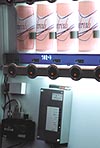 PHONE HOME
PHONE HOME
The two box-like wireless devices at the bottom, which fit into any generic vending machine, are part of DoCoMo Machine Communications' Mobile Ark offering. The Ark is basically a cellphone hooked up to a small processor, and allows the machine to report data (stock level, amount of money in the coin box, mechanical problems, ambient temperature, et cetera) to a central server via NTT DoCoMo's nationwide DoPa wireless network. The Ark adds about ¥40,000 to basic machine cost, but Shinichi Hagiwara, manager at the Tokyo-based company, says that most vending machine makers already include the processor unit, lowering the cost by half. Coke has had 10,000 Ark-equipped machines in use in Hokkaido since March 1999.
www.docomo-machine.co.jp
|
|
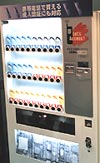 COKE BY KEITAI COKE BY KEITAI
This is a concept machine by Sanyo due to appear in force later this year. It will allow mobile phone owners to call up and receive, well, whatever they want -- in this case, a canned beverage. For now, register at the Sanyo i-mode site and you'll get an ID number which you can input into these machines and earn points redeemable for chakumelo downloads. Sanyo wouldn't say much else about this box, but competitor Pro Tect has a similar system; users access a payment center with their mobile phone and enter a PIN number and the ID number of the vending machine. After connecting the phone to the machine to verify purchaser ID, the product is delivered (the fee is added to the phone bill). Pro Tect's system should be out early in 2001.
www.sanyo-vm.com/
|
|
 YOU WON'T EVEN SEE THE MONEY YOU SPEND YOU WON'T EVEN SEE THE MONEY YOU SPEND
This sleek, touch-panel-controlled machine, the Omron Cybergate VQ4511, is a combo ATM and online shopping kiosk, and retails for a cool ¥3 million. The Cybergate lets customers do all the usual banking transactions, obtain local area info, access ecommerce sites (payments can be deducted directly from clients' bank accounts), and view video ads. These machines will go online at banks, convenience stores, and train stations later in 2001 -- all you'll need is your ATM card.
www.society.omron.co.jp/cyber
|
|
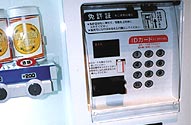 BOOZE BOX BOOZE BOX
OK, so maybe we have a thing for
alcohol. Another ID-dependent machine offered by Fujitaka, the SVM-CBS24F (aka "the Liquor House Mini") goes for about ¥1.3 million and is in use at 6,000 locations around Tokyo. More important, it gives us an excuse to touch upon the economics of vending machines and alcohol. Machines selling sake and beer account for 2.4 percent of all machines, but 10.7 percent of all revenues, implying a higher-than-normal annual revenue per machine of ¥1,974,447. At this rate, a single Liquor House Mini would pay for itself in about eight months.
|
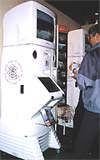 NEW USE FOR ROBBIE THE ROBOT
NEW USE FOR ROBBIE THE ROBOT
V-Sync is a 3-year-old Tokyo-based startup that installs and operates the Music Pod (for "Music Press on Demand"), an audio download kiosk connected at 3 Mbps via optic fiber to a central music file server. Customers use their own MiniDisc to receive copy-protected ATRAC-format music files for ¥150 to ¥500 per title. There are about 200 machines in operation, mostly at train stations and video rental shops around Tokyo. There's also a Web site (www.musicpod.co.jp) and a monthly Pod Magazine where fans can check the latest releases.
|
 PRINTING FOR DIGITAL SNAPPERS
PRINTING FOR DIGITAL SNAPPERS
Omron is also developing the DCS (though it hasn't decided what that will stand for yet!), a stand-alone kiosk where customers can obtain high-res prints of digital photos from any media (Compact Flash, Sony Memory Stick, floppy disk, et cetera) for about ¥100 per print. The device, to retail for some ¥1.6 million, can also scan an original photo and produce a near-perfect copy. The sales guy at this machine did a demo using a Sony digicam and a certain nearby journalist; the quality was surprisingly good. www.omron.co.jp
|

Daniel Scuka
|
|


 ATTENTION GETTER
ATTENTION GETTER WATCH YOUR MANNERS
WATCH YOUR MANNERS IDENTIFICATION, PLEASE
IDENTIFICATION, PLEASE PHONE HOME
PHONE HOME COKE BY KEITAI
COKE BY KEITAI YOU WON'T EVEN SEE THE MONEY YOU SPEND
YOU WON'T EVEN SEE THE MONEY YOU SPEND BOOZE BOX
BOOZE BOX NEW USE FOR ROBBIE THE ROBOT
NEW USE FOR ROBBIE THE ROBOT PRINTING FOR DIGITAL SNAPPERS
PRINTING FOR DIGITAL SNAPPERS



